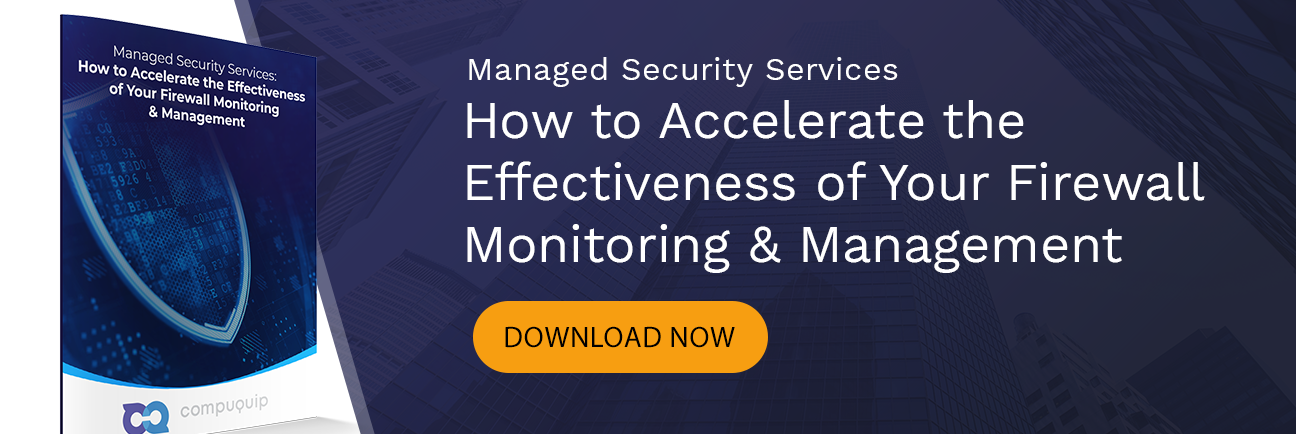How to Enhance Your Firewall Monitoring & Management
No matter the size of your business, having a solid firewall to protect your network from cyber-attacks, data vulnerabilities, and virus risks is critical.
Firewalls are the most reliable form of defense against hackers and network intruders. It can help guarantee that your network won't be affected by outsiders. That said, firewall monitoring is an essential aspect of firewall security protocols.
What is Firewall Monitoring?
If you haven't used firewall monitoring in the past, here is a basic overview of how firewalls work and the benefits of firewall monitoring.
No matter the size of your business, having a solid firewall to protect your network from cyber-attacks, data vulnerabilities, and virus risks is critical.
Firewalls are the most reliable form of defense against hackers and network intruders. It can help guarantee that your network won't be affected by outsiders. That said, firewall monitoring is an essential aspect of firewall security protocols.
Firewall Monitoring Services: How do They Work?
There are a few different models you can go with when contracting firewall monitoring services. Also known as network security devices, firewalls are a barrier between your network and malicious traffic.
There are several kinds of firewall architectures. Your security team's architecture will depend on any previous firewalls to reinforce them and patch any weaknesses. First are packet filtering firewalls, which are the most basic model. They check packet data, like the origin of a packet and the type, without opening the packet.
Then there are circuit-level gateways, which similarly do a superficial transmission control protocol (TCP) check to see if data transmission is legitimate. They are a quick, low-bandwidth firewall, and they don't check packets so that some legitimate TCP handshakes may sneak through. Combination stateful inspection firewalls use the packet inspection method and circuit-level gateway technology, leveling up your protection compared to the first two services.
Going with an even higher level of service, you could opt for application-level gateways. These proxy firewalls block data packets from entering your network. They can identify malware code that could appear legitimate to the more basic firewalls. Finally, there are next-gen firewalls. These custom-developed firewalls can even go into your network and stop ongoing malware attacks. These kinds of firewalls are state of the art and can mean making a substantial investment.
Challenges of Firewall Monitoring
Monitoring your various levels of firewalls is a full-time security operation and, as such, comes with some significant challenges.
First, think about how much protection you need. Some next-gen firewalls that protect sensitive data can significantly slow down your network's internet speed. Suppose you don't need extensive data protection. In that case, you may want to consider investing in a lesser level of data packet inspection in the interest of network speed and agility.
Another common challenge is misconfiguration. You might have anti-spoofing tools to keep malware, spam, and other deceptive traffic away on your managed defense system. If you do not turn this control on, a distributed denial-of-service attack might happen soon enough. Remember, threat actors work round-the-clock to gain access; all they need is one chink in your armor.
Network updates can also be challenging when it comes to firewall management. Many firewall solutions rely on software and will require ongoing updates to ensure they protect your network accurately. Managed firewall services can help you keep track of critical maintenance and upkeep. They also help ensure that you implement the necessary changes to your firewall systems at the right time.
Blocking hostile traffic without impacting legitimate requests can also be problematic. Firewalls are in place to sift through data packets and identify those batches of data that could be dangerous. With the amount of data that software must analyze, it can become impossible to scale and make meaningful decisions regarding what is considered malware or dangerous. A managed firewall service can help ensure critical system updates immediately—which minimizes risk.
Want to know more about how you can improve your firewall management to increase cybersecurity? Download our guide on accelerating your firewalls' effectiveness at the link below.
Download our free guide on accelerating your firewalls' effectiveness at the link below.


